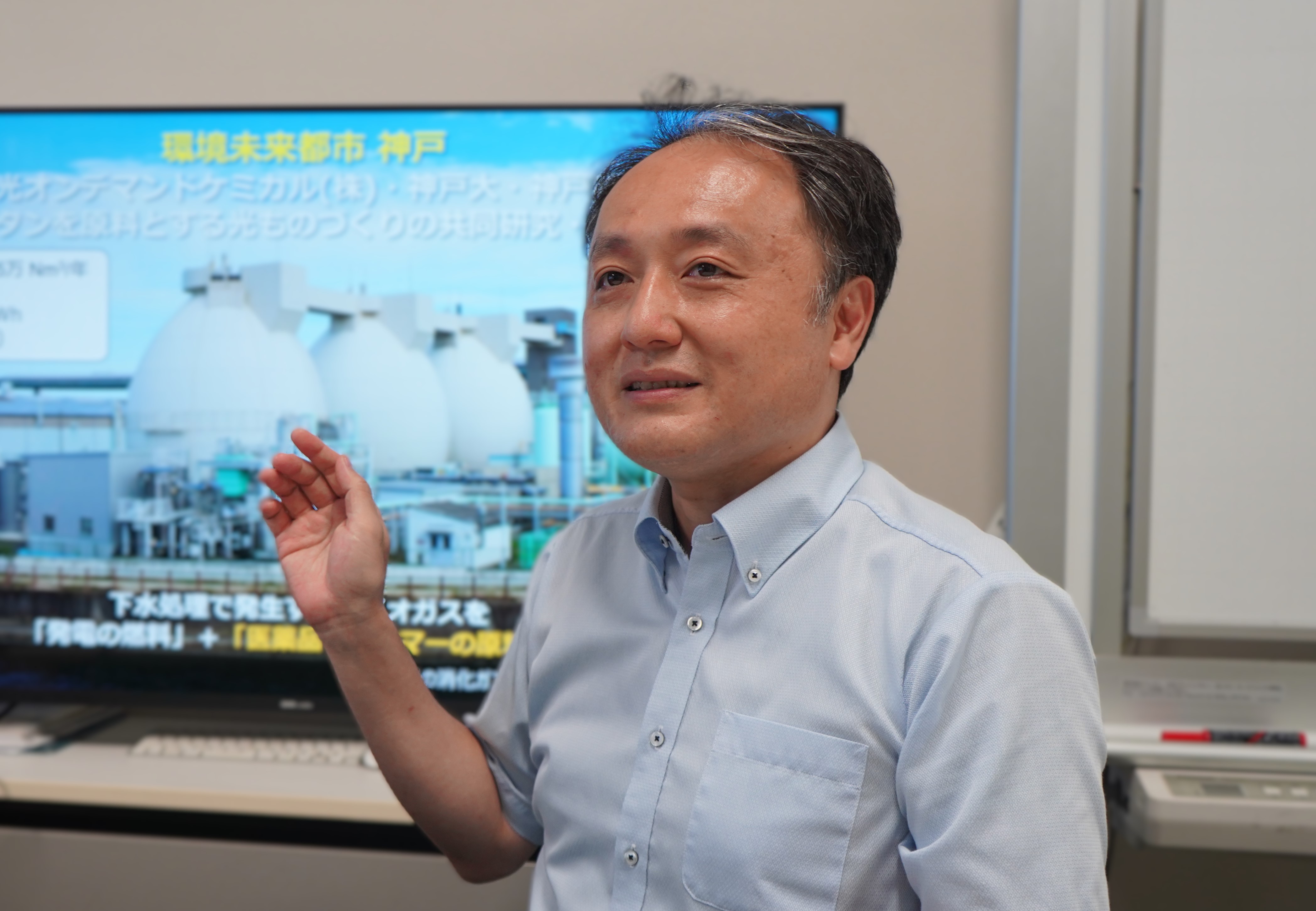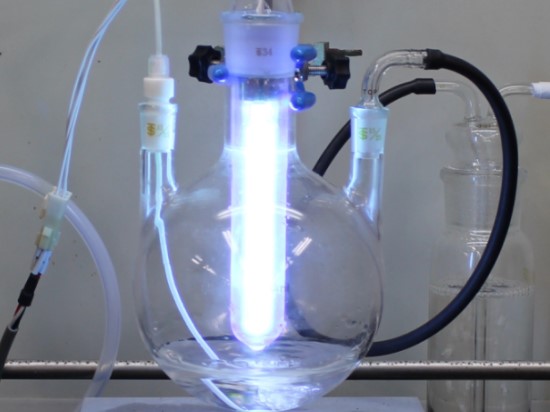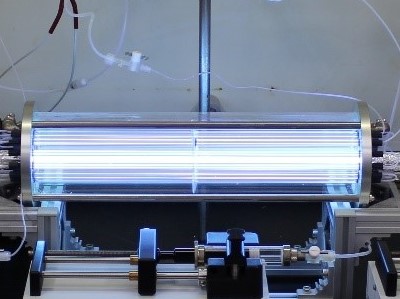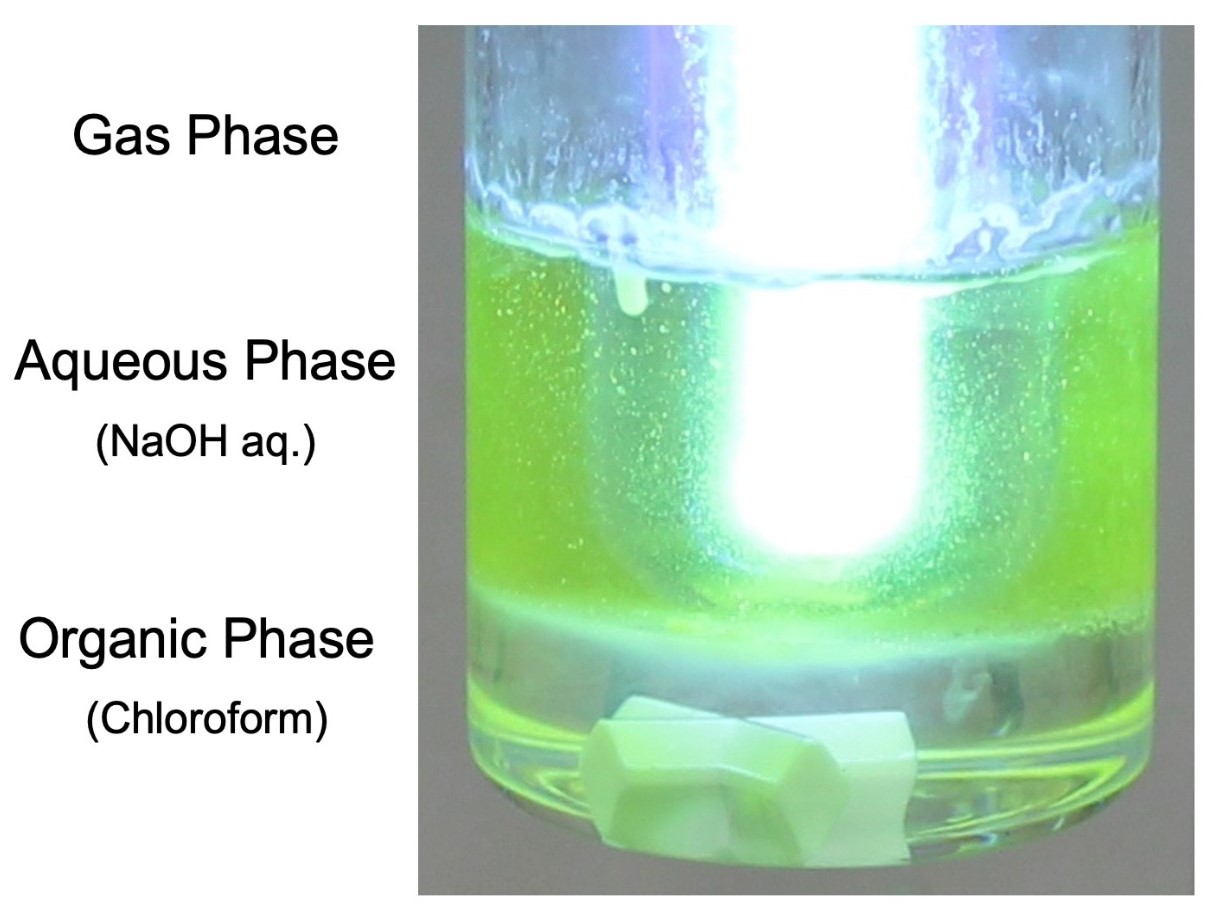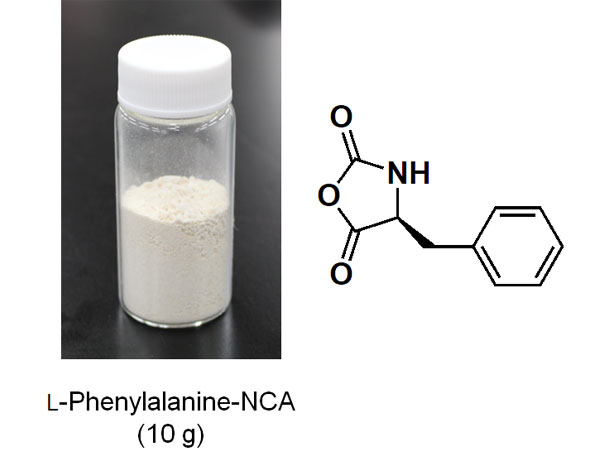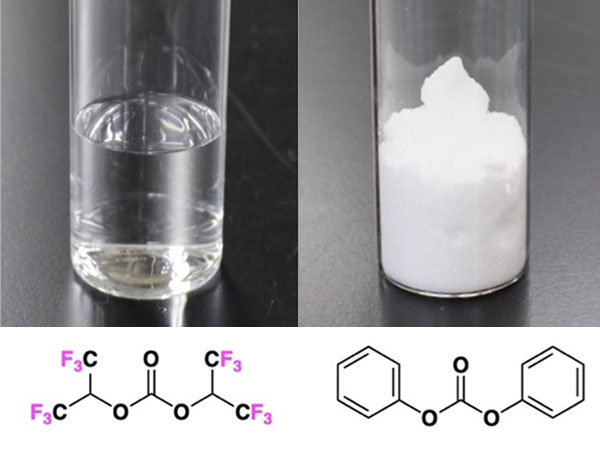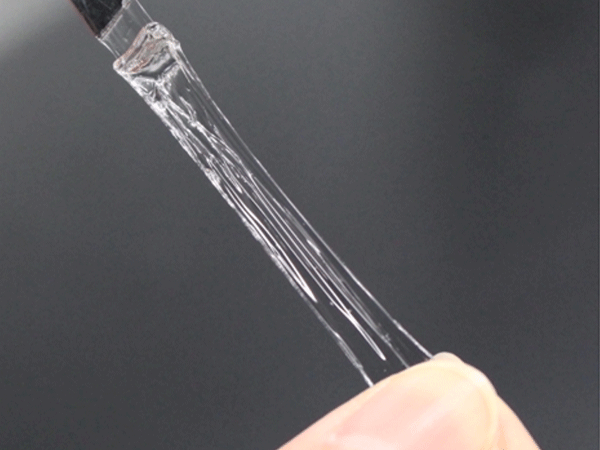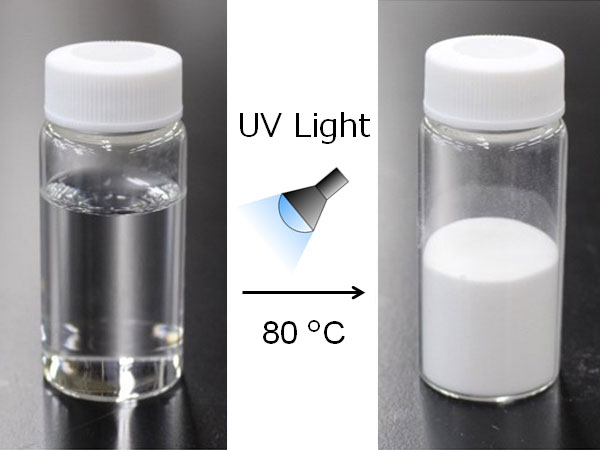Continuous production of useful chemical products using chloroform as a precursor
Various chemical products, such as polymers and pharmaceutical intermediates, are currently synthesized with phosgene as their precursor or raw material. However, phosgene is highly toxic and this usage poses safety risks. Thus, there is demand for the development of new methods and substitutes to replace phosgene. In collaboration with industry, Associate Professor TSUDA Akihiko’s research group at Kobe University Graduate School of Science has become the first in the world to successfully develop a new flow photo-on-demand synthesis system that uses chloroform as the precursor. Using this system, they were able to synthesize phosgene-derived chemical products. Furthermore they achieved a high conversion rate (over 96%), synthesizing these useful compounds in a short period of time (a minute or less of light exposure). The system has multiple advantages; it is safe, inexpensive and simple with a low impact on the environment. It can be used to synthesize various chemical products, which it can produce continuously in large quantities. The researchers expect that this system can be scaled up into a model system of industrial production in the near future.
Patents for this system were filed in Japan in February 2021 and internationally in January 2022. Following the patent announcement in August 2022, the related academic paper was published online in Organic Process Research & Development (OPR&D) on November 11, 2022.
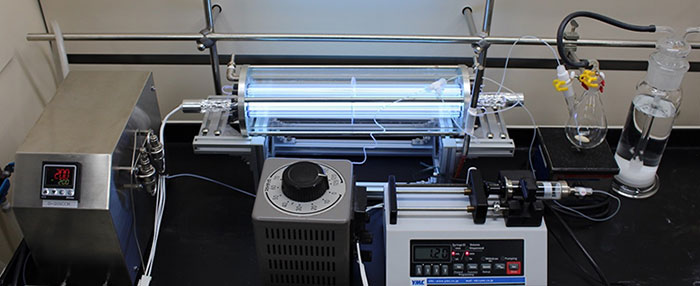
Main points
- From the common organic solvent chloroform and commercially available alcohol, the researchers successfully synthesized pharmaceutical intermediates and polymers at a highly efficient rate (over 96%) and in a short amount of time (a minute or less of light exposure).
- They showed that continuous production is possible, which cannot be done with conventional batch systems.
- In 2 hours, they successfully synthesized up to ten grams of chemical products (and this can be scaled up)
- They synthesized 10 types of functional carbonates and 3 types of polycarbonates as examples.
- Improved safety compared to the standard method of producing phosgene (a strong exothermic reaction of carbon monoxide and chlorine gas that uses a carbon catalyst). The chloroform used as a precursor in the new method is easy to store safely and the chemical reaction can be controlled by exposure to light.
- The byproduct of this new method is mostly hydrogen chloride (neutralized by alkali), therefore dirt does not build up inside the system apparatus. The reduced need to clean the inside lessens the environmental impact and lowers costs.
- The system achieves continuous production without the additional use of organic solvents.
- This new chemical reaction system is expected to make a significant contribution in the move towards carbon neutral and sustainable societies.
Research Background
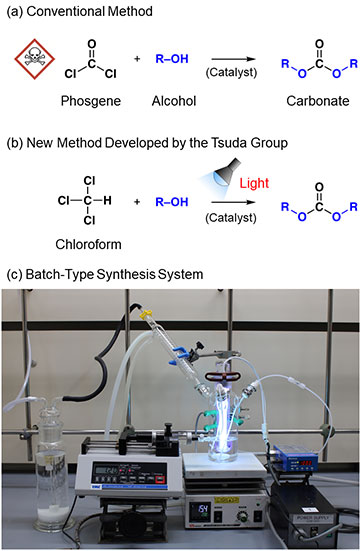
(a) A conventional reaction with phosgene, (b) the photo-on-demand phosgenation reaction developed at Kobe Univ., and (c) a batch-type reaction system for the photo-on-demand chemical synthesis developed atKobe Univ.
Phosgene (COCl2) is used as precursor for polymers and as a pharmaceutical intermediate. The global phosgene market continues to grow by several percent each year, with around 8 to 9 million tonnes produced annually. However, phosgene is extremely toxic. For safety reasons, research and development is being conducted to find alternatives. In a world-first discovery, Associate Professor Tsuda’s research group irradiated chloroform with ultraviolet light, which caused it to react with oxygen and generate high yields of phosgene (patent no. 5900920). In order to do this in an even safer and easier manner, the research group found a way that the phosgene-generating reactions could be instantly performed. They first dissolved the reactants and catalysts in chloroform, and generated phosgene by irradiating the solution with light (patent no. 6057449). In this way, phosgene-based organic synthesis can be carried out as if phosgene wasn’t used.
The research group has named their discovery ‘photo on demand organic synthesis method’ and have successfully used it to synthesize numerous useful organic chemicals and polymers (list of patents (in Japanese): Patents of Tsuda Laboratory ). For example, they successfully synthesized large quantities of chloroformate and carbonate in a safe, inexpensive and simple manner merely by irradiating a mixed solution of chloroform and alcohol (with a base added as needed) with light (Figure 2, for more information see press release (Japanese) and journal paper (English) ).
These highly original reactions developed at Kobe University have been improved through cooperation with domestic chemical companies, and the eventual aim of this research is practical implementation. With the addition of funding from JST A-STEP, further applied research is being conducted, as well the development of functional polyurethane using this synthesis method.
The photo-on-demand organic synthesis method is highly safe and economical, in addition to having a low impact on the environment. Consequently, it has garnered attention from both industry and academia as a sustainable chemical synthesis method (Highlights of Tsuda Laboratory (in Japanese)).
Research Methodology
In this research, a flow photo-on-demand system was redesigned for the photo-oxidation reaction of chloroform. Through experimenting with various flow channel arrangements, materials and light sources, the following system was created as shown in Figures 1 and 3. In the batch photo-on-demand method developed by this research group previously, the photoreaction between the chloroform and oxygen occurs in heterogeneous phases where the chloroform is a liquid and the oxygen is a gas (Figure 2c). However, in experiments using the new system the authors found that the reaction dramatically increased when both were in a gaseous state. By irradiating this gaseous mixture of vaporized chloroform and oxygen under ultraviolet light, the majority (over 96%) was converted into phosgene. Furthermore, the phosgene continuously reacted with the alcohol inside the system (with a base catalyst added as required), which meant that the system could be used to continuously synthesize high yields of chloroformate, carbonates and polycarbonates on a gram scale (Figure 4). These reactions are completed inside the system so the highly toxic phosgene gas does not escape. N-methylimidazole (NMI), which becomes an ionic liquid when it reacts with hydrogen chloride, was used as the base catalyst, so carbonates could be synthesized without using additional solvents. This system can be scaled up further, which will enable it to be used in a wide range of fields from academia to chemical industries.
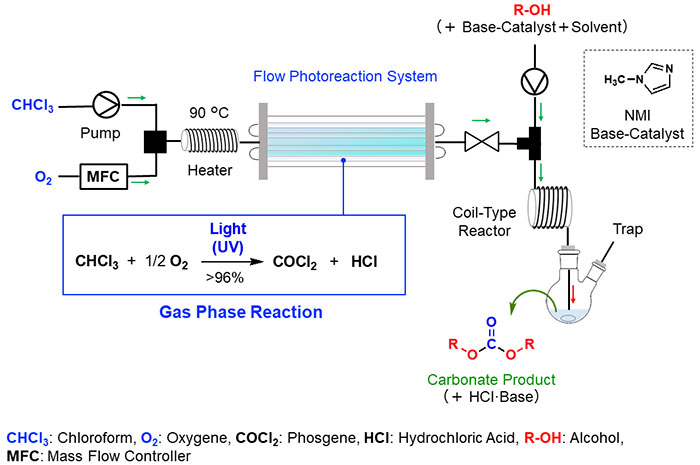
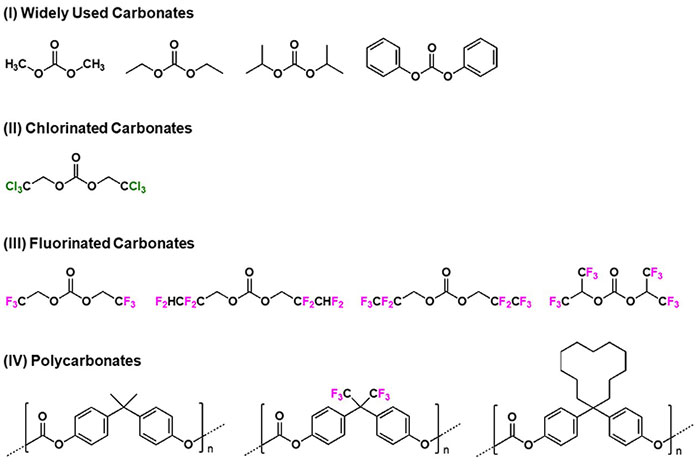
Mechanism: It is thought that the chloroform photo-oxidation reaction is promoted by a radical chain mechanism. The ultraviolet light cleaves the C-Cl bond, which produces chlorine radicals and these radicals become primers that instigate the mechanism.
The researchers confirmed that the chloroform photo-oxidation reaction is extremely energy efficient even when a low-power light source is used. This is due to the oxidation part of the reaction whereby chlorine radicals are repeatedly consumed and regenerated.
Further Developments
The photo-on-demand synthesis method is expected to spark new innovation in how various chemical products are synthesized with phosgene as a precursor. With this new flow photo-on-demand system, it is possible to avoid the dangers of directly using phosgene produced from carbon monoxide and chlorine because the phosgene reaction occurs within the closed environment inside the system. In addition, the system only uses chloroform and oxygen as precursors, meaning that expensive phosgene substitutes are not required. This safe and simple versatile system can be used for the small to large-scale synthesis of various chemical products and the apparatus of this basic model can be customized to suit specific chemical reactions. It is hoped that this system can be used for industrial production by refining the process according to the scale of production. However, this system is not only for large scale chemical production; it will also be of great benefit to chemical manufacturers who need to produce various products on a small to medium scale. It is hoped that it can be used in new ventures, as well as to replace existing set-ups that are wearing out.
Acknowledgements
This research was supported by the Adaptable and Seamless Technology Transfer Program through Target-driven R&D (A-STEP) (seeds development type) from the Japan Science and Technology Agency (JST). ‘Developing highly functional and high added value polyurethane-materials through safe production processes using fluoroalkyl carbonates as key intermediates’ (Principle Researcher: Akihiko Tsuda).
Patent Information
- Presentation Title: Method for Producing Halogenated Carbonyls
- Patent application no.: 2021-21001 (Date of application: February 12, 2021).
- Priority application no.: PCT/JP2022/2661 (Date of application: January 25, 2022).
- Patent publication no.: WO2022172744 A1 (Date of publication: August 18, 2022).
- Presenters: Akihiko Tsuda, and 2 others.
- Applicants: Kobe University, and 2 others.
Journal Information
- Title
- “Flow Photo-on-Demand Phosgenation Reactions with Chloroform”
- DOI
- 10.1021/acs.oprd.2c00322
- Authors
- Yue Liu, Itsuumi Okada, Akihiko Tsuda*
* Corresponding author
Kobe University Graduate School of Science - Journal
- : Organic Process Research & Development (OPR&D)





